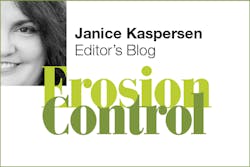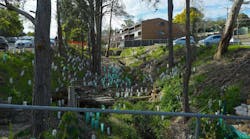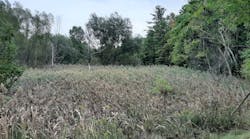
We all know there’s a lot of plastic debris in the sea—from the Great Pacific Garbage Patch that’s at least the size of Texas to the many smaller concentrations throughout all the world’s oceans. But now the problem is moving inland.
Farmers in a desert-like region of northwestern China are using meter-wide white strips of plastic to improve crop yields, or even to grow things that would be impossible without the protective cover. Sometimes referred to as plastic mulch, the polyethylene strips help conserve water, suppress weeds, and increase soil temperatures during the cold months. In a nod to the Green Revolution of the 1970s, some refer to the plastic-enabled crops as the White Revolution.
As this article from The Scientist describes, the method has been used for decades and is increasing; in China alone, plastic covers cropland that’s collectively half the size of California, and many other countries are adopting the practice as well. Most farmers don’t gather up the pieces at the end of the growing season, though—it’s inconvenient and time consuming—and instead leave them in the fields, where they eventually break down into smaller pieces but don’t completely biodegrade. The resulting fragments are known as white pollution.
Just as it does in the ocean, plastic is changing the habitats within the soil. Most of the research on plastics’ effects has concentrated on aquatic environments, so although we know the composition of the soils has changed, we don’t have much data on the long-term result. However, the article notes, “Last year, estimates by a group of Scandinavian and Czech researchers suggested that we could be inadvertently adding some 44,000 to 300,000 metric tons of microplastics annually to farmlands in North America, and another 63,000 to 430,000 tons in Europe.” The amount of plastic now distributed on land could easily exceed the amount in the oceans, and we know that soil organisms are ingesting the fragments.
The effects on aquatic organisms that swallow plastic fragments has been well-documented in everything from fish to seabirds like the albatross. Research on land-based organisms lags behind, but researchers in China have found that both soil microbial biomass and the microbes’ metabolic activity decreases when there is residue from plastic mulch in the soil. Researchers in the Netherlands found that earthworms ingesting microplastics grew slower and died sooner than others, although they still reproduced.
Of greater concern, perhaps, is that the plastics move up the food chain and that we eventually consume them, too. The article includes much more detail on the current research, including potential effects on human biology, and is worth reading.
About the Author
Janice Kaspersen
Janice Kaspersen is the former editor of Erosion Control and Stormwater magazines.

